Longest-separated twins find each other
- Published
Imagine delving into your family history and discovering you have a twin. That's what happened to Ann Hunt, a 78-year-old, who had no idea she had a sibling at all until last year. Now she and twin Elizabeth Hamel have met for the first time since they were babies - setting a new world record.
"Lizzie, Lizzie, how lovely," said Ann when she finally got to hug her sister.
"How lovely to see you in the flesh," said Elizabeth.
Last April, Elizabeth, a 78-year-old from Albany, in the US state of Oregon, was shuffling through her mail when she saw a letter from Aldershot, UK - the town where she was born. "I saw Aldershot, ooh, I did a double-take on that," says Elizabeth. "I opened it up and looked at it, and my eyes popped out my head."
"I am writing to you as I am searching for a family connection," the letter began. Elizabeth knew exactly who this was about, and minutes later she was on the phone to the UK.
On the other end of the line was Ann, her long-lost twin sister. "I was over the moon, I couldn't speak," Ann says. "I let Elizabeth speak mostly, I had to pinch myself because I realised, I've got a sibling, a sister. It's so wonderful, I'm not on my own any more. I've got no words to say. I'm so happy - I have Elizabeth."
Unlike Ann, Elizabeth knew she had a sister.
"I've been praying for you for many years," she told Ann in that first conversation. Over the years she had made some attempts to trace her but without success. It seemed an impossible task. "I thought - being adopted, she could be anywhere in the world," Elizabeth says. "It was amazing to me that she was still in Aldershot."

Ann and Elizabeth as children. They were separated at birth, and Ann was given up for adoption
On 1 May 2014, a year after that first conversation and 78 years after they were separated, Ann and Elizabeth were reunited in Fullerton, near Los Angeles, on Thursday - the longest gap on record, Guinness World Records says.
They were invited to the city by Dr Nancy Segal, a psychologist who has been researching twins, external for more than two decades. Twins who have been brought up separately are of great interest to scientists examining inherited or genetic influences on behaviour. Segal will be looking for similarities and differences during a two-day study, and carrying out DNA analysis to establish whether they are identical or non-identical (fraternal) twins. "What was it in their life that caused the differences? If they're fraternal, it could be character as well as circumstance," Segal says.
"We want to get a comprehensive overview of their lives, their abilities, their interests, and put it all together as an important case study, because this is really the world's longest separated pair of twins."
"I'm 20 minutes older than my sister," says Elizabeth confidently. It's the kind of thing twins often say, but in this case every detail is new and exciting. Elizabeth has been looking forward to taking part in the study. For Ann, it's been about one thing only: "Just getting over there to give Liz a big hug. I can't get there quick enough, to tell you the truth. I'm over the moon. There'll be tears and everything."
The twins were born Elizabeth Ann Lamb and Patricia Susan Lamb on 28 February 1936, in Aldershot, UK. Their unmarried mother, Alice Alexandra Patience Lamb, was in service as a domestic cook. Their father's name was Peters and he was in the army - Aldershot has had a military base since 1854 - but he never saw his daughters.
Ann Hunt grew up in Aldershot as the only child of Hector Wilson and his wife Gladys, who worked as the manageress of the Post Office canteen. The Post Office boys always looked out for Ann.
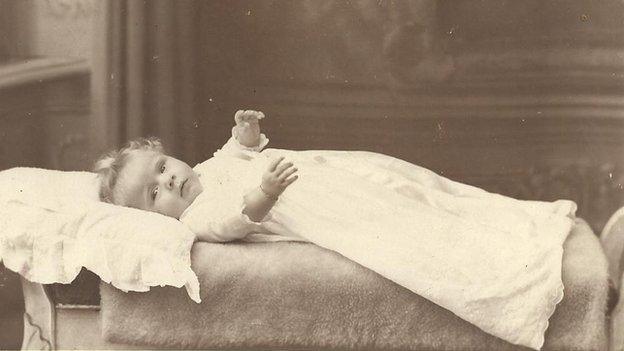
Ann as a baby, after being adopted by Hector and Gladys Wilson. They named her Ann Patricia.
She was 14, when she found out she was adopted. Her aunt told her, so she went home and asked: "Were we adopted, mum?" An odd choice of words. "You and your 'we'," her mum replied. "No, you were a chosen child. God sent you. Your mother wasn't able to keep you, so she allowed me to look after you and to adopt you as mine - someone to love."
Ann doesn't know why she used the word "we" - she doesn't think her adoptive mother had any idea she was a twin. "She would have told me," she says.
So could Ann have had a physical memory of her twin? Dr Segal doesn't think so. "I think people over-romanticise that," she says. "I don't think once they are born they crave physical comfort. A mother who has lost one twin might say: 'The twin is looking for comfort.' Or people say they were unhappy and something was missing - but I think you can read too much into that."
The year Gladys died, in 2001, Ann finally went to the register office to collect a copy of her own birth certificate. It gave her birth mother's name, Alice Lamb. Her occupation was listed as, "a Cook (domestic)". It noted her address, but not her age. There was no mention of any other children on the document either.

Alice Lamb's profession is listed as Cook (domestic)
Ann's youngest daughter, Samantha Stacey, enjoyed investigating family trees, so Ann asked her to find out more about her birth family. It was the start of a long and frustrating process. Initially, all the information was on microfiche - "eye-killing and migraine-inducing", says Samantha. Also, not knowing Alice's age made it quite hard to know when to start looking - they assumed she had been very young when she got pregnant, but in fact she didn't have the twins until she was 33.
Samantha placed ads in the local paper, looked up electoral rolls, and searched online forums. Whenever the search came to a stop, something would start the process off again. After they found Alice's birth certificate, Ann wistfully said: "It would be nice to have a picture." And in 2010, when her husband asked her what she wanted for Christmas, Samantha replied: "Alice's death certificate."
Finally, in 2013, there was a breakthrough. They knew that Alice had got married, at the age of 49, to a George Burton, in Chester, and had a stepson, Albert. Although Albert had also died, they eventually tracked down his son, who said: "Oh yes, Alice has a daughter in the US." That was how they found out about Elizabeth.
Ann remembers her daughter telling her: "We've found your sister but there's a bonus… she's your twin sister." Ann believes it was meant to be. Both sisters have lost their husbands, so this is a real comfort.
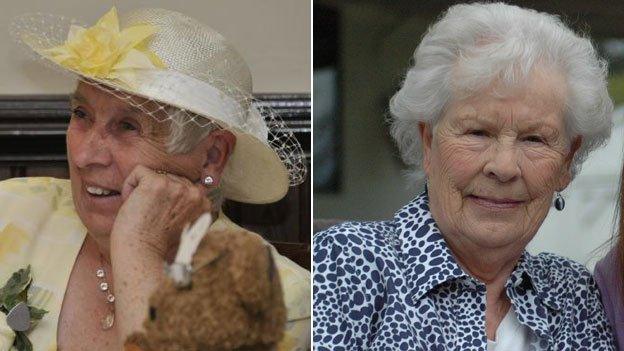
Ann Hunt and Elizabeth Hamel in their 70s
Samantha remembers being a bit apprehensive about telling her mother the news, because Ann was the only one to have been given up for adoption. But she needn't have worried. "She was overjoyed - delighted," says Samantha. "She instantly rang my sisters. She's just very happy about it."
After speaking on the phone, Elizabeth immediately wrote a long letter to her twin to explain why she was the only one to be given up for adoption. "I had curvature of the spine, which in those days was something which made a person unadoptable," she says. "We were both going to be adopted but when mother found out about the curvature of the spine, she decided to keep me."
In 1936, for an unmarried woman in service to keep her child and her job was not easy. There was great stigma around illegitimacy at the time, says social historian Juliet Gardiner, and a woman in Alice's position would usually have been sacked or sent home to her family. "Live-in servants virtually never had children with them - it was another mouth to feed, and might distract the servant from her duties," Gardiner says. There were exceptions. "Occasionally a widow would keep her child, but that child would usually be older and go to school."
"In those days it was a very hush-hush affair," says Elizabeth. "We were both illegitimate, which was very difficult. My mother was a servant living in a home. It was very frightening."
As a consequence, Elizabeth did not live with her mother for quite a few years. At first, an aunt looked after her. Then Alice moved to Berkhamsted to work for Captain Hallam and his wife at Cross Oak, a large house with extensive grounds and full service - butler, cook, gardener and chauffeur - on the outskirts of town.
Elizabeth was then about three or four years old, and was looked after by a woman in Berkhamsted - her mother used to come into town to visit her on her half-day off. One week, she was unable to come on her usual day because of a big dinner party, and when she did arrive - unexpectedly - she was shocked to find her daughter dressed in rags.
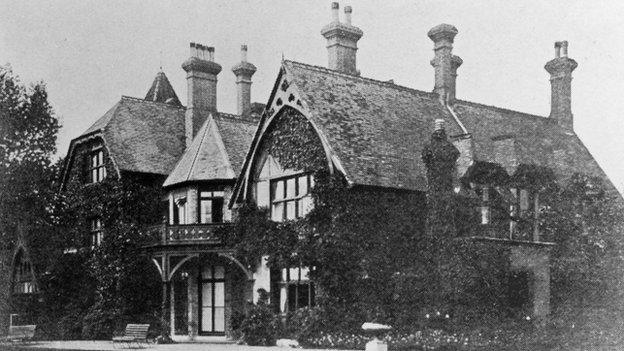
Cross Oak, the house where Alice Lamb was in service when Elizabeth came to live with her (photo courtesy of Berkhamsted Local History &Museum Society)
"She was so upset," says Elizabeth. "She told me: 'I'd made you beautiful dresses and smocked them by hand.'" She immediately took Elizabeth away from there, back to the Hallam's house, where they lived in the servant's quarters. This was during World War II, and Cross Oak was already host to a number of evacuees and even German POWs, who worked on the land. Elizabeth remembers running away from school quite often and having to be taken back by the chauffeur. "Maybe I liked to drive in the car? I don't know."
Later they moved to London with other employers. Alice earned £2 a week plus board, until, relatively late in life, she got married and moved to Chester. Elizabeth was then 15, and it was around this time that she remembers her mother telling her she had a twin. She even saw Ann's adoption papers, although they were lost after her mother died in 1980. "I wish I'd asked more questions now, but all I knew was that I didn't have a father," says Elizabeth. Her cousins, meanwhile, told her very different stories. "One is that grandad, when he found out she was pregnant with twins, said: 'Don't darken my door,' but the other is that he said: 'Go fetch Alice, go and get those twins, get them back.'" But by the time the message reached Alice it was too late. Elizabeth doesn't know which version to believe.
In the ground-breaking Minnesota Study of Twins Reared Apart, which began in 1979 and followed twins who had been separated at birth, illegitimate birth was the most common reason (44.5%) for twins to be separated. This aspect of their story therefore is not unusual, but it is quite rare for one twin to stay with the birth parent when the other is given up. In her book, Born Together - Reared Apart, external, Segal analyses the findings of the 20-year study, which looked at every aspect of separated twins' lives - not just things one might expect to inherit, such as intelligence or physical attributes, but also attitudes, religiosity, life choices - even taste.
One set of separated twins, Bridget and Dorothy, were wearing exactly the same jewellery - seven rings, three bracelets and a watch - when they first met. Another pair, Jim Lewis and Jim Springer, twice married women with the same first name without ever having met.
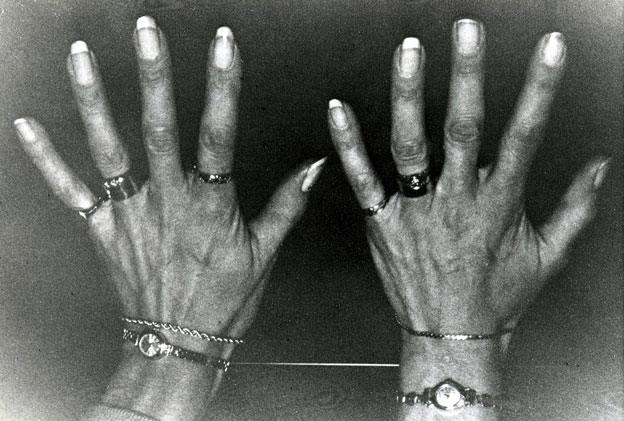
Reared-apart British twins' long, slender hands and fingers, showing their shared taste for jewellery. (Photo courtesy Thomas J. Bouchard Jr. Photograph taken in David Lykken's laboratory.) From the book Born Together - Reared Apart by Nancy L. Segal
"Fascinating work on separated twins shows that here are twins growing up in totally different families, sometimes even totally different cultures, and yet they bring with them similar types of attitudes - in politics, religion, social behaviour," says Segal, director of the Twin Studies Center at California State University. "Where do these things come from? It's difficult to know exactly but it seems that their genes linked to intelligence, personality and temperament just lead them to have similar types of world views."
Ann and Elizabeth both married men called Jim. Ann met her husband Jim Hunt at school, and married him at the age of 25 - he worked as a builder. Three years later, in 1964, Elizabeth married an American, Jim Hamel - although christened Warren, his mother preferred Jim, and that's how he was always known.
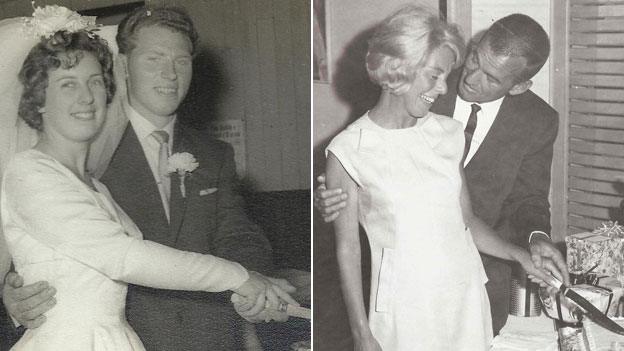
The twins and their husbands - both called Jim - on their wedding day
The twins would appear to have quite a lot in common - both are widowed, both are grandmothers, and both pray. It seems they also like to act up in front of the camera. Samantha says it's hard to find a good picture of Ann "because she's always pulling funny faces." And Elizabeth's son Quinton says of his mother, posing in a cowgirl suit: "She liked to be funny with the camera - and still does."
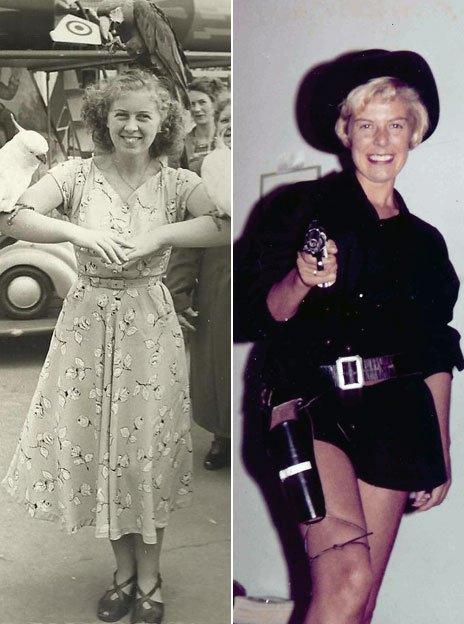
A young Ann and Elizabeth captured in funny poses
Although they think they are not identical twins, they've been poring over photographs, looking for similarities. "When Liz got American citizenship, when she was walking across the stage, it was like looking at myself," says Ann. They've spoken on Skype many times, and think they share some mannerisms - something else which can be inherited, according to Segal.
And do they take after their mother? "I look in the mirror and say 'Hello mother'," says Elizabeth. Ann thinks she has Alice's nose, although people often thought she looked like her adoptive mother, too. "People used to say: 'You're like your mum,' and I used to say 'Oh that's good,'" says Ann. "I think when you're with people you grow like people. You get some of your birth mother's looks and you get some of your chosen mother's ways. When you're a child you seem to copy someone you love."
She has a point. Paradoxically, says Segal, we become more like our biological parents with age, because we have greater control over what we do.
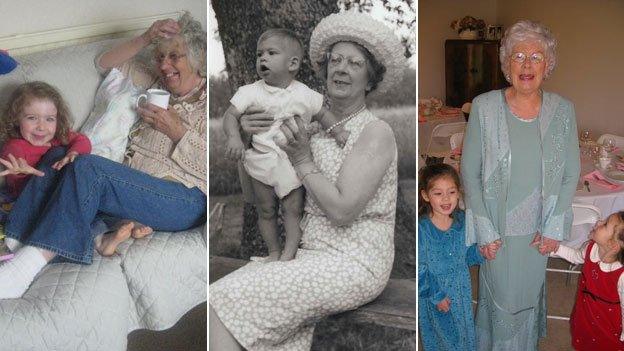
Three grandmothers - Ann, the twins' mother Alice Lamb, and Elizabeth with some of their grandchildren
Clearly, there are also big differences in their lives. After leaving school Ann worked for a printer, until she got married, and remained in Aldershot all her life. Elizabeth left school to work in a sweet shop, but her dream was to join the Navy, and after going to night school she succeeded, joining the WRNS in Portsmouth. She then moved to Malta, where she met Jim on a blind date. "A girl came one night and said: 'Does anyone want to go out with a couple of Yanks?' I said: 'I don't like Americans - too loud.'" But Elizabeth was persuaded, and her impact on Jim was immediate. When he saw her, he said to his friend, "I'll toss you for the blonde." He won the toss and they were married for 48 years, until his death in 2012.
After the two days of interviews and tests, the twins will go back to Elizabeth's home in Oregon where she is throwing a party for Ann, her daughter Samantha - and 80 of her closest friends. "I feel like I've known Liz all my life now," Ann says.
Ann and Elizabeth spoke to Outlook on the BBC World Service. Listen again on iPlayer or get the Outlook podcast.
Follow @BBCNewsMagazine, external on Twitter and on Facebook, external